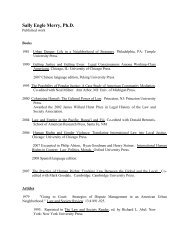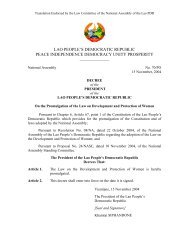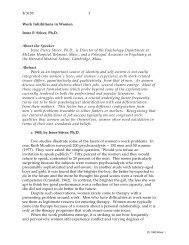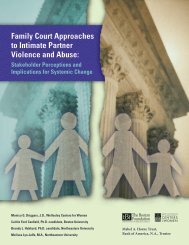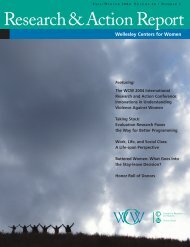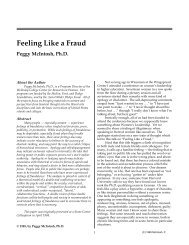Download PDF - Wellesley Centers for Women
Download PDF - Wellesley Centers for Women
Download PDF - Wellesley Centers for Women
Create successful ePaper yourself
Turn your PDF publications into a flip-book with our unique Google optimized e-Paper software.
In 1987 Pamela Seigle, a teacher<br />
and school psychologist, was invited to<br />
work with six teachers from two of the most<br />
diverse schools in Framingham, MA. The teachers<br />
took a leap of faith and signed up to participate in an<br />
action-research project focused on what was then<br />
described as a “coping skills” program. Together, they<br />
explored ways to help young school children develop critical<br />
communication, self-control, and problem solving<br />
skills. They also wanted to discover ways that schools<br />
could create safe learning environments that<br />
would support both the social and academic<br />
success of children.<br />
4<br />
The initial funding <strong>for</strong> this project came from<br />
Grace and Robert Stone, founders of<br />
the Stone Center at the <strong>Wellesley</strong><br />
<strong>Centers</strong> <strong>for</strong> <strong>Women</strong> (WCW),<br />
who were committed to the<br />
importance of prevention<br />
programs in helping<br />
all children become<br />
healthy adults.<br />
“When my parents<br />
founded the Stone<br />
Center, they were clear<br />
that the mission was the<br />
prevention of emotional<br />
problems,” recalls Kathy Stone<br />
Kaufmann, daughter of the<br />
founders. “My father, in particular,<br />
hoped that one of the Center’s projects would<br />
involve working with children in school settings to<br />
develop model programs that would reduce psychological<br />
stress and prevent the kind of serious<br />
problems that my own sister had suffered.”<br />
In the mid-80’s, the Stones helped jump-start<br />
what became known as the Open Circle Program,<br />
and with generous support since 1989 from Pat<br />
and Barbara Roche, Roche Bros. Supermarkets,<br />
Inc., and many other funders, the Open Circle<br />
Program at WCW flourished.<br />
Under the direction and leadership of Seigle,<br />
<strong>for</strong> nearly two decades Open Circle’s dedicated<br />
staff has developed, enhanced, and worked to<br />
implement its model curriculum <strong>for</strong> grades<br />
kindergarten to five. They have trained more than<br />
6,250 teachers who have introduced the Open<br />
Circle Curriculum to more than 300,000 children<br />
in over 285 elementary schools and 100 diverse<br />
communities in New England, New Jersey, and<br />
New York. The impact of Open Circle’s work is<br />
felt even more widely in its role as a model program<br />
in the field. The value of Open Circle has<br />
been demonstrated through scientific research<br />
which shows a marked positive difference in the<br />
behavior of students who participated in Open<br />
Circle during their elementary years, compared<br />
with those who did not. The benefits are evident<br />
as well in the day-to-day lives of scores of children<br />
and educators in schools that use the program.<br />
Open Circle is…<br />
Pencils poised over answer sheets, the time has come<br />
<strong>for</strong> students in Mr. Nguyen’s fifth-grade class to take<br />
one of Massachusetts’ high-stakes, standardized tests.<br />
But first, their teacher reminds them that it would be<br />
good to “calm down.” The students know what to<br />
do. They breathe in slowly and deeply, filling their<br />
bellies with air. “Let’s do that a few more times,” Mr.<br />
Nguyen says. Then they begin.<br />
In Ms. Ricca’s second-grade classroom, students<br />
are using their Open Circle time to plan how to<br />
welcome the new student who is joining their class<br />
next week. “Have you ever gone some place new<br />
where you didn’t know anyone?” she asks. “How<br />
did it feel? What helped you to feel more at<br />
home?” The discussions begin.<br />
Out at recess, a first-grader comes running to<br />
Ms. Rayleen, the playground aide. “He won’t let<br />
me have a turn on the<br />
swing.” Instead of immediately<br />
stepping in herself, Ms. Rayleen first asks the<br />
child, “Is this a Double D?” “No…it’s not,” says the<br />
boy, calming down as he realizes that what’s going<br />
on isn’t really dangerous or destructive. “What can<br />
you do if someone isn’t giving you at turn on the<br />
swing?” Ms. Rayleen prompts. “What are some<br />
things you could say to that person?” Soon, the<br />
boys are playing happily.<br />
Scenes like these happen every day in thousands<br />
of classrooms and playgrounds in hundreds<br />
of elementary schools that use Open Circle.<br />
“At its heart, Open Circle is about building<br />
positive relationships, which are the foundation<br />
<strong>for</strong> the social and academic success of children,”<br />
says Seigle.<br />
To help children develop positive relationships,<br />
now and throughout their lives, Open<br />
Circle provides schools with year-long curricula<br />
<strong>for</strong> each grade level from kindergarten through<br />
fifth grade. The program teaches children social<br />
O P E N<br />
MAKING MAKING A A DIFFERENCE<br />
DIFFERENCE<br />
C I RC LE<br />
and emotional skills,<br />
including how to communicate<br />
effectively, listen well, recognize and<br />
manage emotions, cooperate and collaborate,<br />
respect and appreciate differences, and solve<br />
“people problems.” Open Circle also works to<br />
create a safe and caring environment in the classroom<br />
and school — the type of environment in<br />
which the best teaching and learning can happen.<br />
Schools receive the curriculum through an extensive<br />
training program that helps classroom teachers<br />
and other staff members learn the Open<br />
Circle approach to fostering social and emotional<br />
development.<br />
In Open Circle classrooms, students bring their<br />
chairs into a circle, typically twice a week, leaving<br />
an extra chair open as a sign that a new person—<br />
or a new idea—is always welcome. The classroom<br />
teacher facilitates as students discuss a lesson<br />
topic and take part in an activity, such as a roleplay<br />
or team-building game, that rein<strong>for</strong>ces the<br />
concept addressed. Throughout the rest of the<br />
Research & Action Report | Spring/ Summer 2006 5



